In the rabbitry, a livestock of rabbits is raised to obtain valuable meat, fluff, skins, therefore, special attention is paid to the arrangement of the premises. Large farms are used in animal husbandry, but for a private yard you can build a small rabbitry with your own hands.
- Requirements for the rabbitry
- The device of rabbitries and their varieties
- Multi-tiered farms
- Rabbitry in the pit
- Insulation option
- Choice of installation site, sizes and types of cages
- Materials for making
- Instructions for creating a rabbitry for beginners
- Installation of floor, frame and walls
- Installation of roof, doors
- Internal arrangement
- Winter heating
- Cell care rules
Requirements for the rabbitry
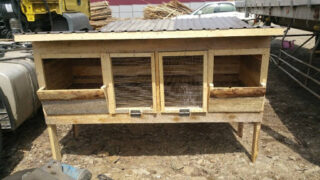
Breeding rooms should not be damp, rabbits grow better if they breathe dry air.
Mini-farms are built taking into account the requirements:
- provide air flow at the rate of 3.2 m3 per hour per individual;
- do not allow drafts;
- calculate the square of 2 - 3 m2 per adult animal;
- prevent the appearance of rodents.
The illumination corresponds to the standards, and the heating provides a temperature of + 8 ° C during the round-up.
The device of rabbitries and their varieties
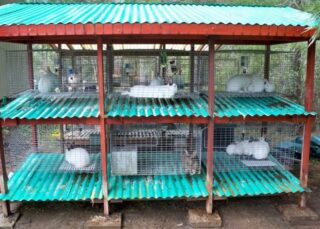
The complex is represented by cells that are grouped in a separate room or stand separately on the street under a canopy.
There are two content schemes:
- In warm closed rabbit farms, rabbits are raised in the north and in central Russia. The adult livestock is housed in individual buildings, and the young are kept in common ones.
- In the outer cages, mature and growing rabbits are also distributed separately. There are walking areas and group cages.
By design, the stands are single or make partitions in large rooms. The cages are made of plywood, chipboard, boards on a frame made of bars or iron elements. Roofing materials are used for awnings.
Multi-tiered farms
A closed rabbit shed contains cages in several rows in height. Tiered structures allow efficient service of animals.
Each floor includes the required parts:
- support for the main stand;
- walking compartment;
- feeder, drinker;
- nest compartment.
The complex has a jigging section for queens. A collection of droppings in the form of a removable box is arranged under the bottom.
Rabbitry in the pit
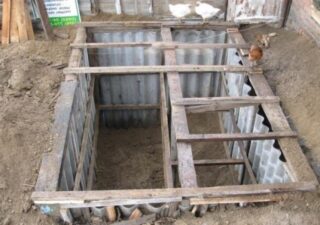
The content is as close as possible to natural conditions, rabbits reproduce quickly. Animals dig passages, thereby increasing the area of the dwelling. A whole system of holes is observed in pits where the livestock has been kept for a long time.
The rabbits go into the pit if they get hungry or, if necessary, to relieve their natural needs. They are far from burying from the main hole.
Insulation option
The stationary rabbitry allows you to raise up to 25 animals in one cage. Provide for automated feeding and cleaning.
The feeders in the rabbit pen are designed so that they do not get dirty, they stay clean. The machines supply and discharge air into the street. In winter, the room is heated so that the breeding, lambing and growth of healthy offspring are not interrupted.
Choice of installation site, sizes and types of cages
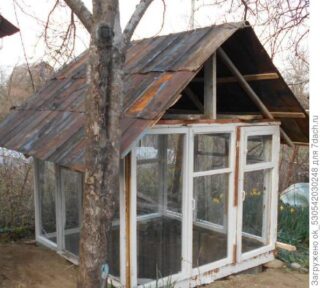
For home maintenance, a cage in the range of 35 - 45 m² is sufficient. Places of detention are separated from the residential building by 15 m. The height of a separate cell is 50-60 cm.
Recommendations for installation conditions:
- Do not place in lowered areas of the yard;
- put in leeward places;
- if the soil is clay, black earth is poured, wooden flooring is made;
- rabbits do not tolerate loud sounds.
In the common barn, together with the cages, they provide an area for storing feed, cleaning equipment. The excrement is used for compost pits, which are located in other parts of the yard.
Common types of cells are used for cultivation:
- Mothers. It is a separate box with a manhole. There is a warm mat inside. The dimensions of the mother liquor depend on the breed of the rabbit. The average internal dimensions of the rabbitry for the uterus are 30 x 50 cm, height - 30 cm, hole size - 15 x 18 cm.
- Adult two-piece cage with a sennik. In warm weather, they are taken out into the open air, and in winter they are placed in a heated barn. The size of the cage is 140-200 cm long, 55-65 cm high, 55-75 cm wide. There is an internal mesh or solid partition.
- Cage with a nest. An insulated box for a rabbit with cubs is installed in the main compartment. The top of the nest is made removable or folding.
- Group kennels. Used for nursing young animals. Calculate 0.12 - 0.17 m² per one growing rabbit.
- Solid wire cage. The walls, ceiling, floor of the room are covered with a net or a fine lattice with links 2.5 x 5 cm. Cells of 1.7 x 1.7 cm are made on the floor. The structures are easy to clean and disinfect.
- Cages for rabbits from Zolotukhin. Combined bottom sheathing - a sloping wall of flat slate at the front, and the floor of the rabbitry at the back is made of mesh. Swivel feeders for easy maintenance.
- Cells from Tsvetkov. Presented in the form of a four-apartment dwelling with automatic ventilation and sewerage. There are suspended queen cells, swivel drinkers and feeders. The hay nursery is upholstered with a metal mesh, fixed to the frame.
The Rabbitax company produces environmentally friendly stands with the same name. They provide for the redirection of air flows. The construction of such cages is recommended for large industrial farms.
Materials for making
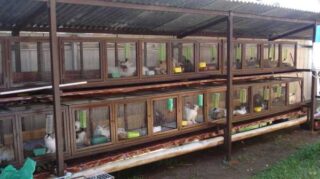
Animals are classified as rodents, therefore, for equipping the rabbitry, the golden eagle is durable materials, so the cage can stand longer without destruction.
Prepare materials:
- steel pipes and corners for the frame;
- lumber - slats, beams, planks;
- galvanized wire mesh;
- roof covering;
- hardware, door sheds, bolts.
A simple drawing of the future product will allow you to make an accurate calculation of the required volume of materials. The scheme necessarily provides for ventilation ducts and gaps.
Instructions for creating a rabbitry for beginners
The technology is followed during manufacture, the work is performed in accordance with the algorithm. They insulate not only the enclosing surfaces, but also the edges of the openings.
Phased execution:
- design the floor;
- put the frame of the walls, sheathe the surface;
- arrange heating, ventilation.
- mount the roof.
Finally, they equip a sennik, feeders, drinkers inside, lay the bedding, disinfect the cage.
Installation of floor, frame and walls
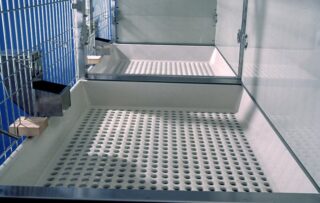
The floors are made mesh, solid and slatted. A one-piece coating is considered unhygienic, it is placed on a slope to facilitate cleaning, holes are drilled to drain the liquid. Hay and straw are applied to rack and mesh surfaces to protect animals from freezing in winter.
The frame is made of timber, iron pipes, galvanized moldings, bolted or welded. The walls are sheathed with a netting. The material is stuffed inside the cage so that the rabbits cannot gnaw on the frame elements. The mesh is fixed with clamps, nailed, sometimes mesh cards are made on a wooden frame.
Installation of roof, doors
Any roofing material is suitable for the cages inside the barn. In an open space, it is better not to use metal, since it gets very hot and creates stuffiness. They put slate, roofing material, euroruberoid.The roof structure consists of transverse beams attached to the frame drains. The coating is stuffed on top.
For doors, a hinged or swing opening option is used. In the first case, the awnings are mounted at the bottom of the opening, and locks are installed at the top. This model is the most acceptable and convenient. Side opening can be single or double leaf. Light corners are used for the frame so as not to make the structure heavier.
Internal arrangement
The dwelling provides for a corner, closed from sight, where the animal hides. They put a box there or assemble a small house.
Table feeders and water tanks are made of wood, because you need an environmentally friendly material and heavy so that it does not tip over. Plastic bowls, gutters are not used due to toxicity.
Feeders are placed along the outer vertical fences for convenient placement of food for the rabbits. The drinker is placed near the side wall.
Provide a container for hay, which is also eaten by rabbits. It is not placed at the bottom of the crate, where it quickly deteriorates.
Winter heating
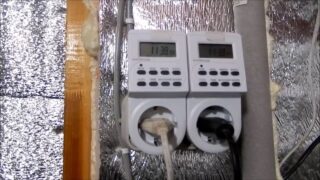
For heating, pipes of the water circuit from various heating units are used. Such a wiring will require a nearby boiler, or the pipes must be pulled over a long distance. They use local heating from a potbelly stove and other homemade stoves.
Electricity is more expensive, but more convenient. Convection heaters, IR emitters are used, heating panels are installed. Warm mattresses are placed on the queens, the walls are sheathed with felt. Outside, foam, mineral wool, extruded polystyrene foam are used. Cold insulation is also installed in the roofing cake.
Cell care rules
The house for maintenance needs to be regularly repaired if animals gnawed on surfaces or other parts. The main procedure is disinfection:
- Firing with a blowtorch. In the flame, harmful microorganisms and insect larvae die. So only wood is processed in combination with metal, and plastic, ceramics, glass are not exposed to high temperatures.
- Disinfection with disinfecting solutions. Chlorine-containing preparations are usually used. Treat all hard-to-reach places with a spray gun. Leave in this form for 1 hour, then remove the agent with a strong stream of water.
The Karcher washing device works effectively. It washes away dirt under pressure and acts with steam on all joints. This is how the cage is treated inside and out.









And why can't you do it according to your mind? Back in the 80s, Mikhailov, the coach of the USSR national athletics team, developed mini farms for rabbits and no pallets, everything falls down and flows down the funnel into the receiver under the cage and the smell of manure does not spoil the rabbits.